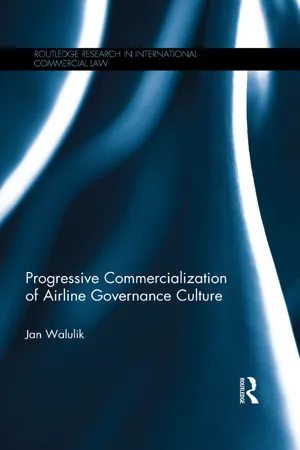As is true of any economic doctrine, aero-nationalism contains some underlying political premises. First of all, in consequence of the experiences of the First and Second World Wars, civil aviation has been bound to the common interest and goals of protecting national security. Second, the division of airspace between sovereign states has given rise to an assumption that each state has its ‘legitimate’ share in international air transport. Lastly, airlines have been perceived as a part of state infrastructure and as a public utility, which was used to justify a protectionist policy under which national airlines were subsidized and protected from foreign competition.
These political considerations fuelled the doctrine of aero-nationalism and served as justifications for the application of its central legal tool – the ‘airline nationality’ concept. Hence, the discussion below demonstrates how the aero-nationalistic assumptions have led to the prevalence of airline nationality requirements.
1.1 Protection of national security
The earliest and fundamental premise of aero-nationalism was the protection of national security. This is not surprising, since aviation developed into an industry thanks to its wide military application during the First World War, when it proved to be an effective force in warfare.1 Thus, industrial aviation became a military power, and for a long time this circumstance has eclipsed civil needs in aviation.2
The protection of national security worked to justify airline nationality. This had two aspects. The first concerned preventing potentially hostile states from entering national airspace. The idea was to limit the access to a nation’s air-space in order to prevent unauthorized photographing of military installations.3 This concern is even reflected in the Chicago Convention,4 which allows for the prohibition or regulation of the use of photographic equipment in civilian aircraft over state territory (Article 36).
Air sovereignty did, in fact, allow nations to close their national airspace to aircraft of a particular state (see Chapter 2.1.1). However, the undesired presence of state A’s aviation activities within the national airspace of state B could also facilitate entry either directly into the airspace of state B or indirectly into the airspace of state C, particularly if the latter had access to points within state B pursuant to a bilateral agreement. The airline nationality concept, implemented as ownership and control tests within national legislation (see Chapter 2.2) and air services agreements (see Chapter 2.1.5), was designed to prevent both of these situations.5 In times of war, similar fears led to the adoption of corporate nationality concepts in some other sectors as well.6
The second aspect of national security as a justification for airline nationality concerned the possibility of making military or other strategic use of civilian aircraft, in particular the deployment of such aircraft for civil defence or emergency needs.7 The assumption was that nationally owned and controlled civil aviation would contribute to political and economic independence, which could be important in crisis situations.8 This latent potential justified the inclusion of airline nationality provisions into domestic laws.
1.2 Protection of ‘legitimate’ share
The recognition of air sovereignty was also attributable to the Great War. This crucial principle of air law developed as a result of unanimous state practice in times of military conflict (see Chapter 2.1.1). Air sovereignty led to the ‘colonization’ of airspace. States began to claim rights to parts of airspace determined by their territories. By virtue of their sovereignty, states were free to rule over their ‘new possessions’, including their commercial use, which led to political demands for ‘legitimate’ shares in aviation commerce.9
The sovereignty principle was confirmed in historical international agreements and in the Chicago Convention (see Chapters 2.1.2–2.1.3). However, Havel and Sanchez maintain that the draftsmen of the Chicago Convention embedded a boldly cosmopolitan telos within the Convention’s Preamble.10 Indeed, the treaty emphasizes that it is ‘desirable to avoid friction and to promote cooperation between nations and peoples’ and that ‘development of international civil aviation can greatly help to create and preserve friendship and understanding among the nations’.
Unfortunately, it appears that most governments paid only scant attention to these provisions and instead focused their attention on the next passage, which states that ‘air transport services may be established on the basis of equality of opportunity’,11 which nation states have often interpreted as a guarantee for a ‘legitimate’ national share in the international aviation market.12 The most popular interpretation of the ‘legitimate’ share concept is that it is a by-product of the air sovereignty principle, as set out in the Chicago Convention. The sovereignty principle, together with Article 6 of the Convention, which makes scheduled international air services dependent on state consent (see Chapter 2.1.3), is alleged to be a justification for states’ claims regarding their shares in international air transport.13
Within this concept, freedom of the air has been considered to form a part of the natural resources of sovereign states.14 It has never been clear what precisely constitutes a state’s ‘legitimate’ share.15 Contemplating a standard contained in the Bermuda I Agreement, Wassenbergh argued that this share is the right to provide capacity for the carriage of a state’s ‘own’ traffic, as defined by the statistics of the air traffic between the state and other states.16 Additionally, some states regard stop-over or even transit traffic through their territories as a part of their ‘legitimate’ share.17
In order to seize and hold onto their ‘legitimate’ shares in practice, states have employed a policy of ‘mutual infringement’ of sovereignty, which has translated into agreements establishing reciprocal...
